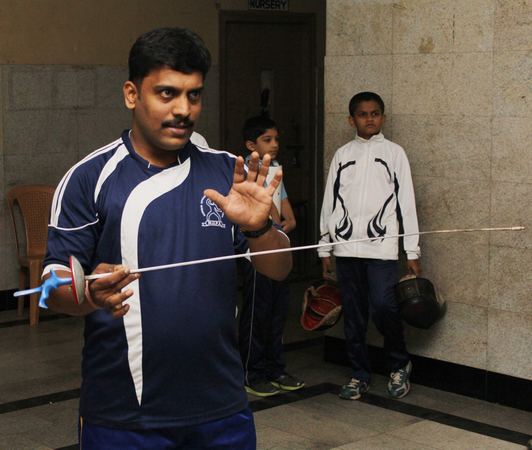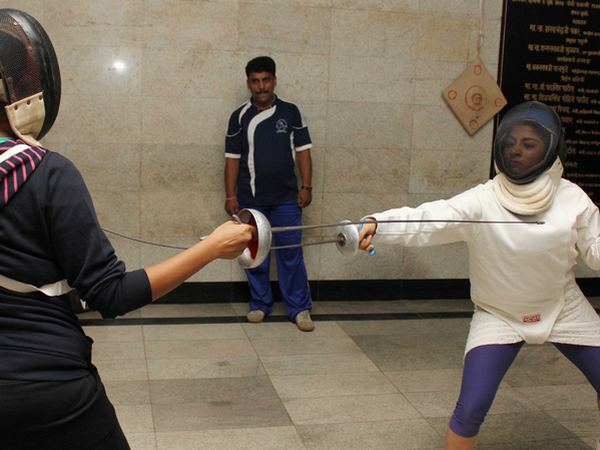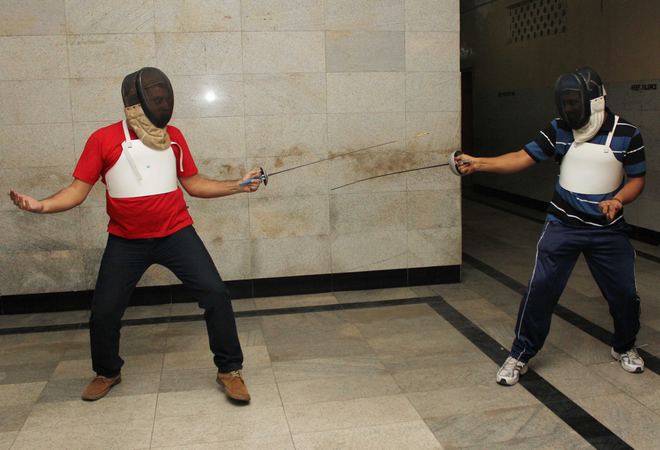 | « Back to article | Print this article |
PICS: Living my Bond fantasy through fencing
Rediff.com's Abhishek Mande fulfilled his long-standing Bond dream as he attended a fencing workshop. He returned enlightened but bruised.
Among all the sports in India that aren't cricket, the least sexy perhaps is fencing. I've found it spectacularly odd considering for a greater part of our country's history wars were fought and won with a sword and little else.
Kalaripayattu, one of our top five exports to the west, consists among other things a sword.
Every picture of every ruler large, small and insignificant almost always has a sword tucked at his/her belt.
So you could understand my frustration when I kept looking unsuccessfully for a fencing instructor in Mumbai where I live.
I had been taken in by the idea of fencing for a while now. (Needless to say, it was planted in my head thanks to the 2002 Bond film Die Another Day.) But it wasn't until a small advertisement in a local newspaper caught my eye.
It showed two fencers in full gear engaged in an elegant battle and instructed me to assemble at a school in a distant Mumbai suburb on a Saturday evening.
Organised by a company called Tushky.com that promises a wide variety of experiences to break the meals-movie-mall routie, the evening promised a fun-filled experience for amateur fencers such as myself.
I walked in about 25 minutes prior to the stipulated time feeling a bit James Bondish only to see an empty (if somewhat derelict) building and a solitary game of cricket (in which the two guards were also participating) in session.
PICS: Living my Bond fantasy through fencing
It would be another couple of hours before my fellow participants would join in and the instructor would line us up.
As I keep looking for a wooden floor room, white suits and swords that drew me into the sport, a bunch of school kids have come along with bags thrice their sizes and started warming up quietly.
A lanky fellow, dressed in a pair of shorts and a t-shirt is in command as the little ones follow his command wordlessly.
I am to find out later that he is a national champion at the inter-school competitions where he beat boys from 58 schools from across India. But Anand Varthi's greatest achievement was winning gold in the under-14 state sub junior championship in 2008 and bronze at the junior national under-19 championship where he was one of the youngest participants.
"There is however little recognition he's got from his school," Kedar Dhawle tells me. "He studies in this very school," he says making a sort of grand gesture.
In Mumbai, there are all of two fencing 'venues' -- both in the western suburbs, making it mighty difficult for people living along the central railway line and places as far as Navi Mumbai and Thane to learn fencing should they want to.
Dhawle is one of the few fencing coaches in the city. He is Varthi's teacher and coaches the state fencing team.
When he had announced the classes for the first time almost a decade ago (and about a year after Die Another Day released) Dhawle received enquiries about the area of the compound that he would be 'fencing'.
Over the years though, those questions have reduced especially when announcements are accompanied by a picture.
"It is a royal game," Dhawle says. It isn't that the irony of the setting -- a poorly-maintained school building with no formal setting or proper equipment -- doesn't strike him as being tragic but it's evident that he's reached a stage where he's willing to work with what he has.
Dhawle was a keen karate player till he discovered fencing in a small Maharashtrian twon called Satara. His teacher was Kavita Mahangde, a national-level fencer.
When he isn't teaching fencing Dhawle runs a small business that makes ends meet. But it doesn't take you long to figure that his heart lies in fencing.
A large part of his class is absent today -- they're participating in a University competition at the other end of the city. So he's left with us.
PICS: Living my Bond fantasy through fencing
We're an assorted bunch -- a doctor couple, two MBA students, a reality TV star and well, me.
Much like me, the other two men too had been inspired by the fencing sequence in the Bond movie. Of the three ladies, two were there for the fun of it. The third however had an agenda.
Neha Soni is a contestant in a reality TV show where she documents her days in five-minute videos. Soni comes from Jamnagar in Gujarat and is in Mumbai to make it big in Bollywood.
Her first big break is a reality show on the channel UTV Bindaas in which she must make clutter-breaking videos to stay on the show. And fencing to her seemed like a good bet.
Kedar Dhawle lines us up and gives us a little speech about fencing. The most important part in the sport, he says is footwork: "We practice footwork every day for 25 minutes before doing anything else. In that sense fencing is a lot like batting. Once you get the footwork right, you're good to go."
"But it is also very boring," he adds with a smile.
And so we're off. We start with a half-squat that we're told is called en-garde, French for 'on guard'. It is the most basic of the positions in fencing and perhaps the least demanding, unless of course you are made to stand in it for a spectacularly long time.
We then graduate to basic footwork that seems easy when Dhawle does it but turns out to be a mighty difficult task when we try. But the most difficult step is the lunge that involves jumping, sliding and sticking the sword in the opponent's heart.
"Don't sweat over this; you won't get it so soon," Dhawle assures us.
Finally after making us sweat for over an hour, Dhawle decides it's time to bring out the swords.
PICS: Living my Bond fantasy through fencing
It is the moment we've all been waiting for. But before we engage, we are to know the different kinds of swords.
Foil is a light weapon whose target areas include the torso, neck and groin including the back but not the arms. It has a pistol grip that can give you the impression that it's perhaps broken. Weighing 550gms and measuring 120 cm, Foil is the lighter cousin of the Eppe.
Eppe looks similar to foil except that it weighs 770 gm and has a larger guard. In an eppe combat, touches by the side of the blade do not halt the action. Unlike foil and sabre, the 'right of way' is not applicable in eppe which means if participants score hits simultaneously, both earn points. The target area for eppe is the entire body.
Sabre is the most conventional of the three weapons -- one that Dhawle likes to call 'Shivaji Maharaj sword'. It has a proper handle that makes it more recognisable among the three but also makes it more difficult to wield. Hits with the edges of the blade are allowed and the target area of the weapon is the entire body above the waist.
I am handed a foil meant for left-handed people. My opponent is a doctor who lunges at me. Before I can react, I feel the point of his eppe thrust in my armpit. I pull back, blurt out a couple of explicatives and adjust my chest guard.
This is supposed to be my James Bond moment, I tell myself and jump back into the fray. I manage to get a couple of hits in the doctor's chest before he misses the mark again hitting me this time, just above my waist!
We keep at it for a while, both of us trying to live our Bond fantasies when I lunge and miss. My sword hits his right armpit; it's his turn to pull out.
The evening has crept swiftly upon us. It is pitch dark outside and the only lights visible are of the single store in the lane. About this time, we realise, as gallant as this thing looks, neither of us were cut out for fencing. We shake hands and limp away.



